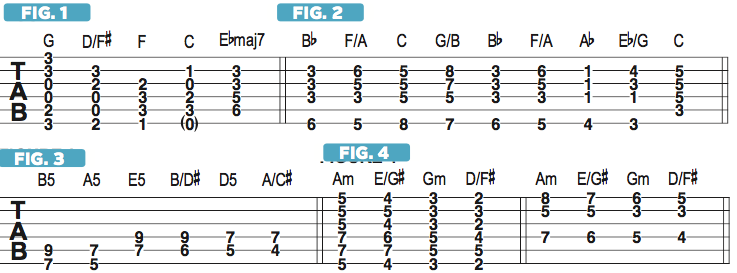Using First-Inversion Chords to Create Smooth Bass Motion
Some musically appealing ways that great songwriters have used first-inversion chords to craft progressions behind their melodies.
Over the past several lessons, we’ve been looking at brief sections of well-known songs that feature a chord progression with a bass line that either drops chromatically or walks down the major scale while chord tones above it remain stationary (as common tones), descend or chromatically ascend, which creates sweet-sounding contrary motion. As you recall, the progressions incorporated the use of first- and second-inversion chords, for which the lowest note is the chord’s third or fifth, respectively. I’d now like to point out some other musically appealing ways that great songwriters have used first-inversion chords to craft progressions behind their melodies and create smooth, step-wise bass motion, meaning either a half step or whole step, as opposed to the big, angular intervallic skips of a perfect fourth or fifth.
A great example of what I’m talking about here can be found in the verse progression to the Nineties alternative rock hit “Plush” by Stone Temple Pilots, wherein guitarist Dean DeLeo plays the open chords G, D/F#, F and C, followed by a third-position Efmaj7 while bassist Rob DeLeo (who wrote the song’s music) underscores the bass motion of the chord voicings and additionally plays an E note, the major third of C, beneath brother Dean’s C chord, creating a warm and sonically clear C/E sound overall (which works well with the guitar’s overdriven tone) and the chromatic drop G F# F E Eb. As in FIGURE 1, the use of the first-inversion chords D/F# and C/E is the key element that produces the harmonic warmth and richness.
The third chord in the verse riff to AC/DC’s hard-rock anthem “Back in Black” is another great example of how well it works, sonically, to have the bass play the third of the chord while overdriven guitars play a straight and sonically stable power chord above it, as bassist Cliff Williams plays a low C#, the major third of A, below Angus and Malcolm Youngs open A5 power chords.
In the celebrated live recording of Sir Paul McCartney’s early-Seventies, post-Beatles pop hit “Maybe I’m Amazed,” featured on 1976’s Wings over America,” he plays, on piano, the verse chord progression Bb F/A C G/B Bb F/A C, which, right before the chorus, he expands to Bb F/A C G/B Bb F/A Ab Eb/G C. FIGURE 2 presents a nice, conveniently symmetrical set of guitar voicings for these changes. Again, note the smooth chromatic bass drop created by the use of first-inversion chords.

The verse and chorus progression to the early-Eighties Southern-rock radio hit “Hold on Loosely” by .38 Special offers a similar example of how to employ first-inversion chords to create step-wise bass motion, in this case using the minimalist two-note voicings illustrated in FIGURE 3. Many modern hard rock, prog and metal bands such as Dream Theater, Nevermore and Lamb of God have also employed these two-note shapes in their songs, no doubt due to the sonic clarity they provide when played with heavily saturated, high-gain guitar tones.
Another example of a similarly descending chromatic drop from the classic rock era can be found during organist Jon Lord’s solo in Deep Purple’s tour de force, “Highway Star,” where the progression goes Am E/G# Gm D/F#. Guitarist Ritchie Blackmore simply and unobtrusively octave-doubles the descending bass line with single notes while Lord quickly arpeggiates the chords as fast 16th notes. FIGURE 4 offers full barre-chord voicings for these majestic-sounding chords, as well as sparser, more open-sounding voicings that are also easier to fret.
In a completely different style, Steely Dan’s 1972 radio-friendly jazz-rock hit “Reelin’ in the Years” offers a fine example of economy of notes with the use of first-inversion chords, as pianist Donald Fagen, bassist Walter Becker and guitarist Denny Dias craft a light, yet warm- and tender-sounding verse accompaniment with sparsely-voiced major, minor, minor seven and diminished chords. FIGURE 5 offers a composite set of voicings for one guitar. Note the use of sweet-sounding open 10th intervals (a major or minor third plus an octave), the high A common tone among all the chords and that Dsdim (D# F# A) may alternatively be reckoned as the first-inversion dominant seven chord B7/D#, without the B root.
All the latest guitar news, interviews, lessons, reviews, deals and more, direct to your inbox!

Over the past 30 years, Jimmy Brown has built a reputation as one of the world's finest music educators, through his work as a transcriber and Senior Music Editor for Guitar World magazine and Lessons Editor for its sister publication, Guitar Player. In addition to these roles, Jimmy is also a busy working musician, performing regularly in the greater New York City area. Jimmy earned a Bachelor of Music degree in Jazz Studies and Performance and Music Management from William Paterson University in 1989. He is also an experienced private guitar teacher and an accomplished writer.

